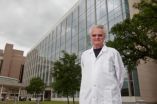(Press-News.org) Researchers at UCLA have found a possible explanation for why autistic children act and think differently than their peers. For the first time, they've shown that the connections between brain regions that are important for language and social skills grow much more slowly in boys with autism than in non-autistic children.
Reporting in the current online edition of the journal Human Brain Mapping, senior author Jennifer G. Levitt, a professor of psychiatry at the Semel Institute for Neuroscience and Human Behavior at UCLA; first author Xua Hua, a UCLA postdoctoral researcher; and colleagues found aberrant growth rates in areas of the brain implicated in the social impairment, communication deficits and repetitive behaviors that characterize autism.
Autism is thought to affect one in 110 children in the U.S., and many experts believe the numbers are growing. Despite its prevalence, little is known about the disorder, and no cure has been discovered.
Normally, as children grow into teenagers, the brain undergoes major changes. This highly dynamic process depends on the creation of new connections, called white matter, and the elimination, or "pruning," of unused brain cells, called gray matter. As a result, our brains work out the ideal and most efficient ways to understand and respond to the world around us.
Although most children with autism are diagnosed before they are 3 years old, this new study suggests that delays in brain development continue into adolescence.
"Because the brain of a child with autism develops more slowly during this critical period of life, these children may have an especially difficult time struggling to establish personal identity, develop social interactions and refine emotional skills," Hua said. "This new knowledge may help to explain some of the symptoms of autism and could improve future treatment options."
The researchers used a type of brain-imaging scan called a T1-weighted MRI, which can map structural changes during brain development. To study how the brains of boys with autism changed over time, they scanned 13 boys diagnosed with autism and a control group of seven non-autistic boys on two separate occasions. The boys ranged in age from 6 to 14 at the time of the first scan; on average, they were scanned again approximately three years later.
By scanning the boys twice, the scientists were able to create a detailed picture of how the brain changes during this critical period of development.
Besides seeing that the white-matter connections between those brain regions that are important for language and social skills were growing much slower in the boys with autism, they found a second anomaly: In two areas of the brain — the putamen, which is involved in learning, and the anterior cingulate, which helps regulate both cognitive and emotional processing — unused cells were not properly pruned away.
"Together, this creates unusual brain circuits, with cells that are overly connected to their close neighbors and under-connected to important cells further away, making it difficult for the brain to process information in a normal way," Hua said.
"The brain regions where growth rates were found to be the most altered were associated with the problems autistic children most often struggle with — social impairment, communication deficits and repetitive behavior," she added.
Future studies using alternative neuroscience techniques should attempt to identify the source of this white-matter impairment, the researchers said.
"This study provides a new understanding of how the brains of children with autism are growing and developing in a unique way," Levitt said. "Brain imaging could be used to determine if treatments are successful at addressing the biological difference. The delayed brain growth in autism may also suggest a different approach for educational intervention in adolescent and adult patients, since we now know their brains are wired differently to perceive information."
###Other authors on the study included Paul M. Thompson, Alex D. Leow, Sarah K. Madsen, Rochelle Caplan, Jeffry R. Alger, Joseph O'Neill, Kishori Joshi, Susan L. Smalley and Arthur W. Toga, all of UCLA. Support was provided by the National Institutes of Health, the National Alliance for Autism Research, the National Institute of Mental Health and the National Institute of Neurological Disorders and Stroke. The authors report no conflict of interest.
The UCLA Laboratory of Neuro Imaging, which seeks to improve understanding of the brain in health and disease, is a leader in the development of advanced computational algorithms and scientific approaches for the comprehensive and quantitative mapping of brain structure and function. The laboratory is part of the UCLA Department of Neurology, which encompasses more than a dozen research, clinical and teaching programs. The department ranks first among its peers nationwide in National Institutes of Health funding.
For more news, visit the UCLA Newsroom and follow us on Twitter.
Autistic brains develop more slowly than healthy brains UCLA researchers say
Imaging study shows slower growth extends into adolescence
2011-10-22
ELSE PRESS RELEASES FROM THIS DATE:
NOAA, NASA: Significant ozone hole remains over Antarctica
2011-10-22
The Antarctic ozone hole, which yawns wide every Southern Hemisphere spring, reached its annual peak on September 12, stretching 10.05 million square miles, the ninth largest on record. Above the South Pole, the ozone hole reached its deepest point of the season on October 9 when total ozone readings dropped to 102 Dobson units, tied for the 10th lowest in the 26-year record.
The ozone layer helps protect the planet's surface from harmful ultraviolet radiation. NOAA and NASA use balloon-borne instruments, ground instruments, and satellites to monitor the annual South ...
Space weather prediction model improves NOAA's forecast skill
2011-10-22
NOAA is now using a sophisticated forecast model that substantially improves predictions of space weather impacts on Earth. Better forecasts offer additional protection for people and the technology-based infrastructure we use daily.
Explosions in the sun's outer atmosphere – tracked and forecast by NOAA scientists – can cause geomagnetic and solar radiation storms at Earth that can impede the operation of electrical power grids, interfere with the normal function of Global Positioning Systems and temporarily hamper radio and satellite telecommunications. Grid and satellite ...
Panera Bread Locations of the Bronx Celebrates Autumn with Seasonally-Inspired Flavors
2011-10-22
Autumn at Panera Bread is all about the best ingredients and flavors that warm from the inside out. To celebrate the transition into Fall, Panera is offering a variety of seasonally inspired flavors with the return of some favorite feel-good foods and the introduction of exciting new items.
New this Fall is the Roasted Turkey Artichoke Panini. Made with all-natural roasted turkey, artichoke-Parmesan spread, roasted red peppers, caramelized onions and fresh baby spinach, all expertly grilled on Asiago Cheese Focaccia, it can be savored alone or paired with Panera's Mac ...
Hudson Valley Panera Bread Locations Celebrate Autumn with Seasonally-Inspired Flavors
2011-10-22
Autumn at Panera Bread is all about the best ingredients and flavors that warm from the inside out. To celebrate the transition into Fall, Panera is offering a variety of seasonally inspired flavors with the return of some favorite feel-good foods and the introduction of exciting new items.
New this fall is the Roasted Turkey Artichoke Panini. Made with all-natural roasted turkey, artichoke-Parmesan spread, roasted red peppers, caramelized onions and fresh baby spinach, all expertly grilled on Asiago Cheese Focaccia, it can be savored alone or paired with Panera's Mac ...
Scientists determine family tree for most-endangered bird family in the world
2011-10-22
Using one of the largest DNA data sets for a group of birds and employing next-generation sequencing methods, Smithsonian scientists and collaborators have determined the evolutionary family tree for one of the most strikingly diverse and endangered bird families in the world, the Hawaiian honeycreepers.
Not only have the researchers determined the types of finches that the honeycreeper family originally evolved from, but they have also linked the timing of that rapid evolution to the formation of the four main Hawaiian Islands.
"There were once more than 55 species ...
Homicide, suicide outpace traditional causes of death in pregnant, postpartum women
2011-10-22
AUGUSTA, Ga. – Violent deaths are outpacing traditional causes of maternal mortality, such as hemorrhage and preeclampsia, and conflicts with intimate partner are often a factor, researchers report.
"We found that the mortality rate from homicide and suicide were more common than what we think of as traditional causes of maternal mortality," said Dr. Christie L. Palladino, an obstetrician-gynecologist and educational researcher at Georgia Health Sciences University. "It's not what you want to read, but it's the reality."
The analysis of the Centers for Disease Control ...
Panera Bread Celebrates Autumn with Seasonally-Inspired Flavors in Westchester County
2011-10-22
Autumn at Panera Bread is all about the best ingredients and flavors that warm from the inside out. To celebrate the transition into Fall, Panera is offering a variety of seasonally inspired flavors with the return of some favorite feel-good foods and the introduction of exciting new items.
New this Fall is the Roasted Turkey Artichoke Panini. Made with all-natural roasted turkey, artichoke-Parmesan spread, roasted red peppers, caramelized onions and fresh baby spinach, all expertly grilled on Asiago Cheese Focaccia, it can be savored alone or paired with Panera's Mac ...
New drug strategies for Alzheimer's, multiple sclerosis examined at UH
2011-10-22
HOUSTON, Oct. 20, 2011 – Researchers at the University of Houston (UH) are recommending a new strategy for developing drugs to treat cancer, multiple sclerosis, Alzheimer's and cardiovascular diseases.
In an invited review published in the October issue of Nature Reviews Drug Discovery, scientists at the Center for Nuclear Receptors and Cell Signaling (CNRCS) at UH outline the results of years of research following the team's 1996 discovery of the estrogen receptor beta (ERβ).
"We have known for some time that female sex hormones – estrogens – influence a number ...
West Nile virus transmission linked with land-use patterns and 'super-spreaders'
2011-10-22
After its initial appearance in New York in 1999, West Nile virus spread across the United States in just a few years and is now well established throughout North and South America.
Both the mosquitoes that transmit it and the birds that are important hosts for the virus are abundant in areas that have been modified by human activities.
As a result, transmission of West Nile virus is highest in urbanized and agricultural habitats.
"The virus has had an important impact on human health in the United States partly because it took advantage of species that do well around ...
Inconsistent evaluations may affect promotion of women in law firms
2011-10-22
Los Angeles, CA (October 20, 2011)- Partners in Wall Street law firms write equally nice things about the work of their male and female junior lawyers, but when they use hard numbers, they rate the men higher, according to a study in the current Social Psychological and Personality Science (published by SAGE).
The use of positive language may be to soften the blow of low evaluations or they may be based on lower expectations of female performance based on stereotypes, write Monica Biernat, of the University of Kansas, M.J. Tocci of Fulcrum Advisors and Joan Williams ...
LAST 30 PRESS RELEASES:
World-first discovery uncovers how glioblastoma tumours dodge chemotherapy, potentially opening the door to new treatments
A fatal mix-up: How certain gut bacteria drive multiple sclerosis
New AI tool identifies not just genetic mutations, but the diseases they may cause
Deep-learning model predicts how fruit flies form, cell by cell
Combination pills for high blood pressure may simplify treatment, improve long-term health
Immune system keeps mucosal fungi in check
Neurons within the brain use simple rules to localize genetic messages
Electrodes created using light
Second-hand gift-giving is a well-deliberated decision
How human interaction drove evolution to make bears less aggressive
National Poll: Few parents offer teens guidance on healthy eating during holiday season
Cannabis derivatives could provide new ovarian cancer treatments
Raising strong yeast as a petroleum substitute
Clues to the origin of hot Jupiters hidden in their orbits
Canada’s reduced pledge to Global Fund will impact domestic health
1 in 4 children with major traumatic injuries not cared for in pediatric trauma centres
Duke and Duke-NUS’ joint cross-population research to uncover "East-West" differences in disease and care
Scientists to ‘spy’ on cancer- immune cell interactions using quantum technology breakthrough
Tech savvy users have most digital concerns
Making lighter work of calculating fluid and heat flow
Normalizing blood sugar can halve heart attack risk
Lowering blood sugar cuts heart attack risk in people with prediabetes
Study links genetic variants to risk of blinding eye disease in premature infants
Non-opioid ‘pain sponge’ therapy halts cartilage degeneration and relieves chronic pain
AI can pick up cultural values by mimicking how kids learn
China’s ecological redlines offer fast track to 30 x 30 global conservation goal
Invisible indoor threats: emerging household contaminants and their growing risks to human health
Adding antibody treatment to chemo boosts outcomes for children with rare cancer
Germline pathogenic variants among women without a history of breast cancer
Tanning beds triple melanoma risk, potentially causing broad DNA damage
[Press-News.org] Autistic brains develop more slowly than healthy brains UCLA researchers sayImaging study shows slower growth extends into adolescence




